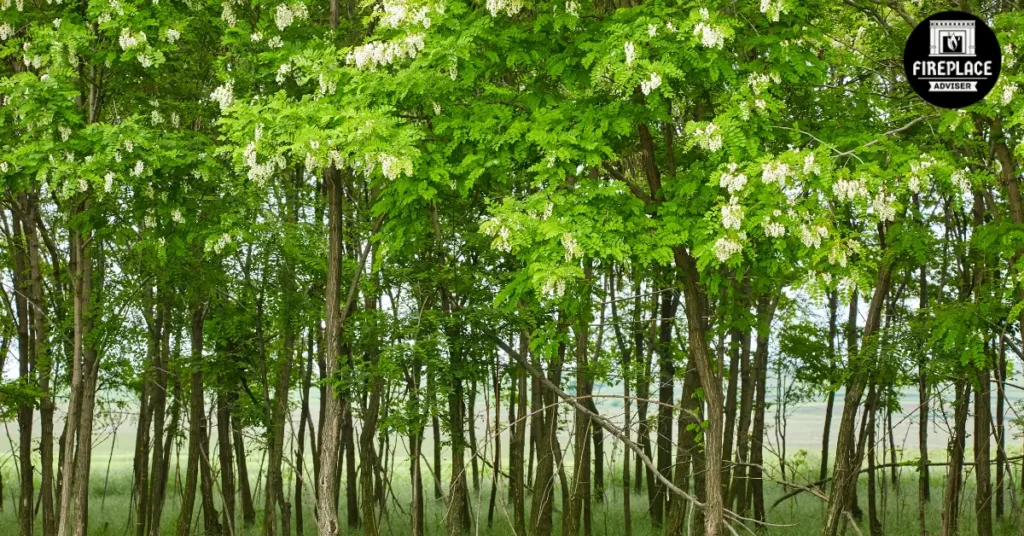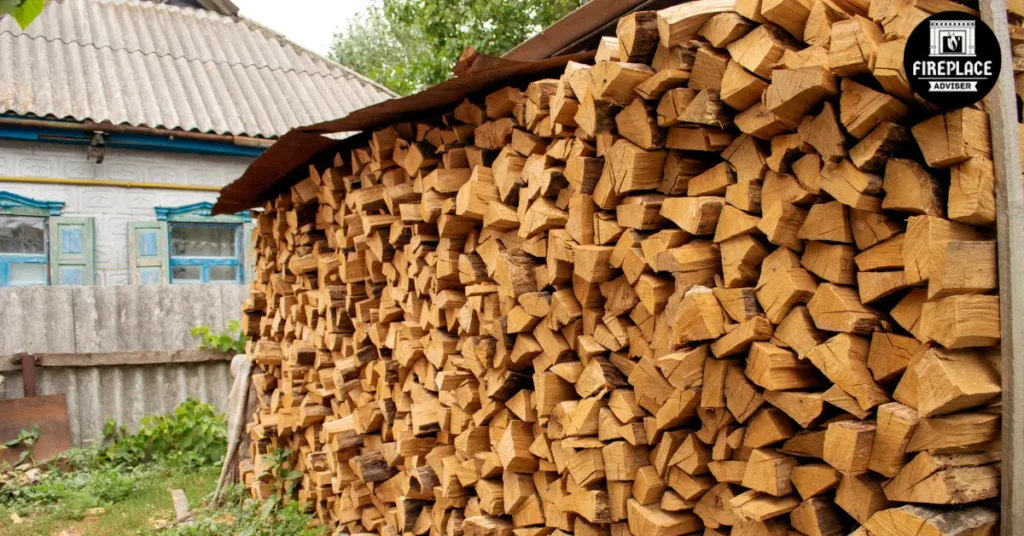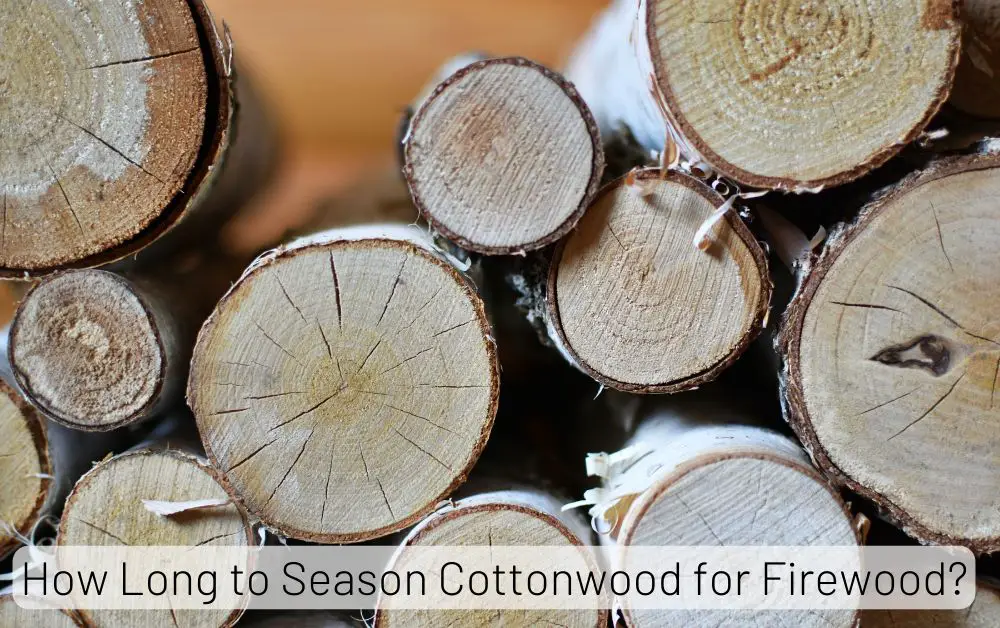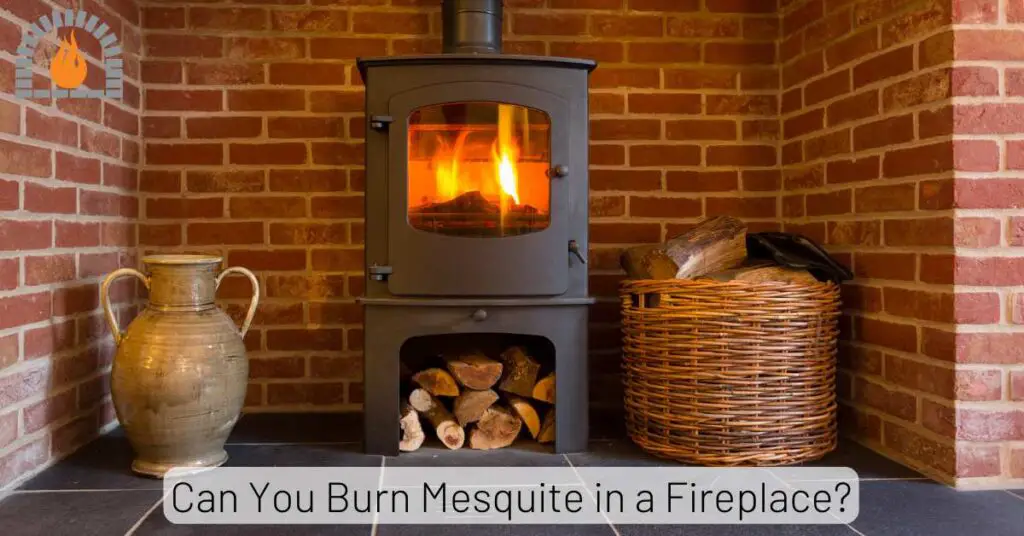The options can be overwhelming when choosing the best firewood for your stove or fireplace. One name that often surfaces in discussions among seasoned wood burners is Black Locust. Known for its durability and dense wood, Black Locust is touted by many as a top-tier firewood. But is it worth the hype? Is black locust good firewood?
Black Locust Firewood Overview
| Characteristic | Description |
|---|---|
| BTU | High (~28.3 million BTUs per cord). |
| Nature of Smoking | Low; burns clean with minimal smoke. |
| Nature of Popping | Low; minimal popping and crackling. |
| Nature of Sparking | Low; produces few sparks. |
| Ease of Seasoning | Moderate; takes about 1-2 years to season properly. |
| Ease of Splitting | Difficult; dense and tough wood grain. |
| Moisture Content | Low when properly seasoned; high moisture content when green. |
| Density | Very dense; one of the hardest domestic hardwoods. |
| Burn Duration | Long-lasting burn due to high density. |
| Heat Output | Excellent; provides consistent, long-lasting heat. |
| Aroma | Mild and pleasant when burning. |
| Insect Resistance | High; naturally resistant to insects and decay. |
| Creosote Buildup | Low; burns hot and clean, reducing creosote accumulation in chimneys. |
| Cost | Moderate to high; can be more expensive due to its high quality and demand. |
| Common Uses | Ideal for heating homes, cooking in wood stoves, and outdoor fire pits. |
| Sustainability | Generally considered sustainable; often harvested from managed woodlots. |
What is a Black Locust?
Black locust, scientifically known as Robinia pseudoacacia, is a fast-growing deciduous tree. It’s known for its rugged, rot-resistant wood and beautiful clusters of fragrant white flowers.
Besides being used as firewood, black locust wood is popular in outdoor construction, such as fence posts and decking, due to its resistance to decay. It’s also used in making furniture and other woodworking projects.
Is Black Locust Good Firewood?
Black locust is good firewood because it offers high heat output, long burn time, and minimal smoke production. This dense and hard wood produces around 27.9 million BTUs per cord, making it one of the most efficient firewood available. Its low moisture content and natural resistance to rot and insects ensure it seasons quickly and last longer in storage.
While black locust can be challenging to split due to its hardness, its superior burning qualities and clean performance make it a top choice for heating your home. If you’re looking for firewood that delivers exceptional warmth and efficiency, black locust is an excellent option.

Black Locust Firewood Key Characteristics
High Heat Output: Black Locust firewood is known for its exceptional heat output. It produces approximately 27.9 million BTUs per cord, among the highest of any firewood species. This makes it ideal for heating purposes.
Density and Hardness: Black locust is a very dense hardwood. This density contributes to its long burning time and high heat production. Because it is so hard, splitting Black Locusts can be more challenging than splitting softer woods.
Low Moisture Content: Black Locust naturally has a lower moisture content than many other wood types. When correctly seasoned, it burns efficiently with less smoke and creosote buildup, which is beneficial for maintaining chimney health.
Burning Characteristics: It burns hot and slow, providing a steady, long-lasting fire. Its coals are excellent for sustained heat, making it a preferred choice for overnight burns in wood stoves.
Aroma and Smoke: When burned, Black Locust has a relatively mild aroma compared to other hardwoods. It produces a low amount of smoke, making it a cleaner-burning option.
Environmentally Friendly Choice: Black Locust trees rapidly grow and are frequently classified as invasive in certain regions. This characteristic ensures a steady wood supply, making it a more sustainable option than slower-growing hardwoods. By choosing Black Locust, you’re making a responsible choice for the environment.
Durability: Due to its density and hardness, Black Locust is resistant to rot and pests, making it a durable option for firewood and other applications, such as fence posts and outdoor furniture.
Sparking: When burned, it tends to spark more than some other hardwoods, so it is recommended that you use a fireplace screen to prevent potential fire hazards from flying embers.
Pros of Black Locust Firewood
- High heat output (27.9 million BTUs per cord)
- Long burn time
- Low smoke production
- Minimal sparks and popping
- High density
- Low moisture content
- Pest resistance
- Versatile uses beyond firewood
Cons of Black Locust Firewood
- Due to its dense and demanding nature, black locusts can be challenging to split, requiring more effort and sometimes specialized tools.
- The hardness of black locust can cause more wear and tear on cutting and splitting equipment.
- Its high density makes it heavier to handle and transport, which can be cumbersome.
- While it has a low moisture content, black locusts can still take significant time to season and reach optimal burning conditions properly.
- Depending on your location, black locust firewood might be harder to find than more common types like oak or maple.
- Black locust firewood can be more expensive because of its desirable burning properties and sometimes limited supply.
- Some people find the smell of burning black locusts unpleasant compared to other hardwoods.
Related Post: An Ultimate Guide to Oak Firewood
Black Locust Burning Qualities
Black locust (Robinia pseudoacacia) is highly regarded for its superior burning qualities, making it one of the best available firewood. It has an exceptionally high energy content, producing approximately 29 million BTUs per cord, ensuring a hot and long-lasting fire.
The wood is dense and complex, contributing to a slow and steady burn and reducing the need for frequent replenishment. When correctly seasoned, black locust has a low moisture content, resulting in minimal smoke and creosote buildup, which enhances safety and efficiency.
It produces very few sparks, making it a clean and safe option for indoor fireplaces and wood stoves. The pleasant aroma it emits when burned further enhances its appeal.
Overall, black locust’s excellent heat output, efficient burn, and clean combustion make it a top-tier firewood choice.

Safety and Creosote Production
Black locust is valued for its excellent burning qualities, safety, and low creosote production. When correctly seasoned, black locust firewood has a low moisture content, typically around 20%, which is crucial for safe burning.
Dry wood burns more efficiently and generates less smoke, significantly reducing creosote accumulation in chimneys. Creosote is a highly flammable substance that can build up in the chimney and pose a severe fire hazard.
By minimizing creosote formation, black locust helps lower the risk of dangerous chimney fires, making it a safer option for home heating. Additionally, black locust produces few sparks and minimal smoke during combustion, enhancing safety, particularly for indoor use in fireplaces and wood stoves.
Its clean-burning nature ensures better air quality inside the home and reduces the need for frequent chimney cleaning.
Overall, black locust’s ability to burn efficiently with low creosote production makes it a safe and reliable choice for firewood, contributing to both household safety and maintenance ease.
Related Post: Firewood Smell Like Poop
Environmental Impact and Sustainability
As a fast-growing hardwood, black locust regenerates quickly, making it a renewable resource when harvested responsibly. Its ability to thrive in various soil conditions, including poor and degraded soils, allows it to be cultivated in areas unsuitable for many other tree species, thus contributing to land rehabilitation and erosion control.
The environmental benefits of using black locust firewood also extend to its burning characteristics. Because it burns efficiently and produces high heat output with minimal smoke, so it contributes less to air pollution than softer woods with higher moisture content. This cleaner burn produces fewer harmful particulates and greenhouse gas emissions, supporting better air quality and a lower carbon footprint.
Furthermore, the black locust’s natural resistance to pests and diseases reduces the need for chemical treatments in its cultivation, promoting a more organic and eco-friendly approach to forestry. This resistance also extends the lifespan of black locust trees and wood products, leading to more sustainable use over time.
Practical Tips for Using Black Locust Firewood
Proper Seasoning of Black Locust
- Seasoning Time
- Black locust firewood should be seasoned for at least six months to a year to reduce moisture content and ensure optimal burning efficiency.
- Best Practices for Storing
- Store black locust firewood in a dry, well-ventilated area, preferably off the ground, to prevent moisture absorption and promote airflow.
Efficient Burning Techniques
- Mix small and large pieces when burning black locusts to maintain a steady and long-lasting fire. Avoid overcrowding the firebox to allow for proper airflow.
Tips for Starting and Maintaining Fire
- Start the fire with smaller kindling and gradually add larger pieces of black locust. Use newspaper or fire starters to ignite the kindling effectively.
Tools and Accessories Needed
- Essential tools include a fireplace poker, tongs, and a sturdy grate for holding the firewood. Additionally, keep a supply of firewood nearby for easy access.
Safety Considerations
- Handling and Storing Safely: Wear gloves when handling black locust firewood to protect your hands from splinters. Stack firewood safely to prevent collapse and injury.
- Fire Safety Tips: Install a spark arrestor on your chimney to prevent sparks from igniting nearby combustibles. Ensure the fireplace or wood stove is adequately maintained and inspected regularly.

Comparing Black Locust to Other Firewood
| Feature | Black Locust | Oak | Maple | Birch | Ash |
|---|---|---|---|---|---|
| Density (lbs/ft³) | 49-55 | 45-50 | 42-47 | 43-47 | 40-45 |
| Heat Output (BTU/cord) | 26-30 million | 24-28 million | 22-26 million | 20-24 million | 24-26 million |
| Seasoning Time | 1-2 years | 1-2 years | 1-2 years | 1-2 years | 1-2 years |
| Smoke | Low | Medium | Medium | Medium | Low |
| Sparking | Low | Low | Low | Medium | Low |
| Splitting Ease | Medium | Medium | Medium | Easy | Easy |
| Scent | Mild, sweet | Mild, earthy | Mild, sweet | Mild, sweet | Mild, earthy |
| Availability | Widely available | Widely available | Widely available | Widely available | Widely available |
| Decay Resistance | High | Medium-High | Medium-High | Medium-High | Medium-High |
| Overall Popularity | Growing | Popular | Popular | Popular | Popular |
How to Identify Black Locust
- Black locusts have deeply furrowed, dark bark and yellowish-brown heartwood. The wood is tough and dense.
- The leaves are pinnately compound, and the tree produces clusters of white, fragrant flowers in late spring.
Cost of Black Locust Firewood
- Black locust can be more expensive than other types of firewood due to its high demand and exceptional qualities.
- Despite the higher cost, black locust’s efficiency and long burn time make it a cost-effective option in the long run.
FAQs
Is Black Locust Safe to Burn Indoors?
Yes, black locusts are safe to burn indoors when correctly seasoned. It produces minimal smoke and creosote.
How Long Does Black Locust Take to Season?
Black locust typically takes about a year to season thoroughly, although this can vary depending on the climate and storage conditions.
Can You Mix Black Locust with Other Firewood?
Mixing black locusts with other firewood can help balance easy lighting and long burn times.
Does Black Locust Create Creosote?
When correctly seasoned, black locust produces very little creosote, making it a safer option for your chimney.
What Are the Best Alternatives to Black Locust?
Other high-efficiency firewood like oak, hickory, and maple are excellent alternatives to black locusts.
Final Thoughts: Is Black Locust Good Firewood?
Black locust is an excellent firewood choice due to its high heat output, long burn time, and minimal smoke production. However, it can be hard to split and requires proper seasoning.
If you’re looking for reliable, efficient, eco-friendly firewood, black locust is a top contender. Its benefits far outweigh its drawbacks, making it a worthwhile investment for your heating needs.
Affiliate Disclosure: Fireplaceadviser.com is a participant in the Amazon Services LLC Associates Program. We may earn a commission when you click on certain links on this site and purchase.

Hello!! I am Jamal Khan. I often fix my home electric heaters and gas stove problems and research the common issues in the heating units to improve my knowledge and expertise. The aim of establishing fireplaceadviser.com is to share my expertise and knowledge with my audience.


















